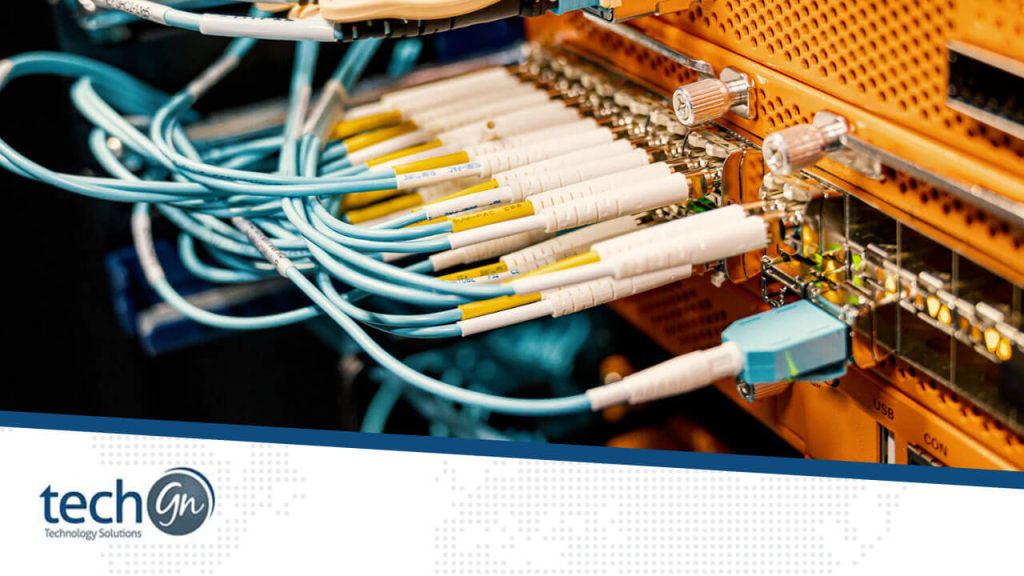In today’s fast-paced digital world, every business depends on a reliable and fast network. Whether you run a small office or a growing enterprise, your internet connection and internal network are the backbone of your operations.
One of the biggest decisions you’ll face when designing or upgrading your IT infrastructure is whether to go with structured cabling or rely primarily on a wireless network.
At TechGN, we work with companies of all sizes to help them choose the best networking solutions based on their unique needs. In this post, we’ll break down structured cabling vs wireless networking so you can decide what’s best for your office.
What is Structured Cabling?
Structured cabling refers to a standardized, organized system of hard-wired network cables that connect your office devices—computers, printers, VoIP phones, access points, and servers—to your network switch or router.
These systems typically include:
- Category 6 or Cat6a Ethernet cables
- Patch panels
- Wall jacks
- Cable management racks and trays
- Network switches
Structured cabling provides a physical network infrastructure for both internet access and internal communication.
What is Wireless Networking?
A wireless network, or Wi-Fi, uses radio signals to allow devices to connect to the internet or local servers without using cables. Wireless networks use access points (APs), routers, and wireless controllers to manage signals and connect users.
While nearly every office has some form of Wi-Fi, some businesses rely entirely on wireless infrastructure—especially startups or companies that prioritize mobility.
Pros and Cons of Structured Cabling
Pros:
1. Reliable and Stable Connections
Cabled connections are immune to signal interference and provide consistent speeds without sudden dropouts. Great for mission-critical workstations or servers.
2. Faster Speeds and Lower Latency
Wired networks offer higher bandwidth and lower ping times compared to Wi-Fi, which is crucial for:
- Video conferencing
- VoIP phone systems
- Cloud services
- File sharing between users
3. Enhanced Security
Wired networks are physically harder to access and less vulnerable to hacking or unauthorized access.
4. Better for High-Density Environments
Large offices or co-working spaces can experience signal overload on Wi-Fi. Structured cabling ensures every user has stable access.
5. Scalability
A well-planned cabling system makes it easy to add new workstations, phones, or devices without restructuring your whole network.
Cons:
1. Higher Initial Cost
Installing structured cabling requires materials, labor, and planning. Costs can increase for large offices or retrofitting older buildings.
2. Lack of Flexibility
Devices must be connected to a wall port or jack, limiting employee mobility unless you combine with wireless.
3. Installation Time
Structured cabling takes time to install properly, especially in new buildings or offices with poor cable routes.
Pros and Cons of Wireless Networking
Pros:
1. Mobility and Flexibility
Wireless lets employees work from anywhere in the office—desks, meeting rooms, lounges, or even outside.
2. Easy to Set Up
Adding new devices to a Wi-Fi network is quick. No need to run cables or install new ports.
3. Lower Upfront Costs
Wireless networks require fewer physical materials. You only need a good router or wireless access point (WAP) to get started.
4. Modern Collaboration
Wi-Fi supports mobile devices like tablets, laptops, and smartphones used in collaboration, cloud access, and video conferencing.
Cons:
1. Signal Interference and Dropouts
Walls, other devices, and even microwaves can weaken Wi-Fi signals. This leads to inconsistent speeds and connectivity.
2. Security Risks
Wireless networks are more exposed to unauthorized access, data breaches, and attacks unless secured with firewalls and strong encryption.
3. Speed Limitations
Even with Wi-Fi 6, wired Ethernet still beats wireless for raw speed and lower latency.
4. Performance Degradation
Too many users or connected devices can choke wireless bandwidth, especially without proper access point distribution or mesh systems.
When to Choose Structured Cabling
Structured cabling is ideal when:
- You need high-performance and low-latency for servers or VoIP
- Your office is large or has many users
- You use data-heavy applications like AutoCAD, video editing, or large cloud backups
You need reliable uptime for customer service, IT helpdesks, or remote work
When to Choose Wireless Networking
Wi-Fi is the better fit when:
- Your team uses mobile devices and laptops frequently
- You want a clean aesthetic with fewer wires
- Your business operates in a small space or co-working environment
You need to support hot desks or remote workers who drop into the office
The Best Approach? Combine Both
At TechGN, we often recommend a hybrid approach. Here’s how:
- Use structured cabling for your core office needs: desktops, printers, VoIP phones, and servers.
- Layer in wireless for guest access, mobile users, and flexible collaboration spaces.
This combination gives you the best of both worlds—stability and flexibility—without sacrificing performance or security.
What Structured Cabling and Wireless Have in Common
| Feature | Structured Cabling | Wireless Networking |
|---|---|---|
| Speed | High | Moderate to High (Wi-Fi 6/6E) |
| Reliability | Very High | Medium |
| Security | Strong (physical) | Needs strong encryption |
| Scalability | Excellent | Good with proper AP setup |
| Cost (Initial Setup) | Higher | Lower |
| Mobility | Low | High |
| Maintenance | Low | Medium (firmware updates, interference) |
Ready to Future-Proof Your Office Network?
Contact TechGN for a free consultation and let us guide your business through the decision between structured cabling and wireless solutions.
Reviews
Tailoring Solutions


